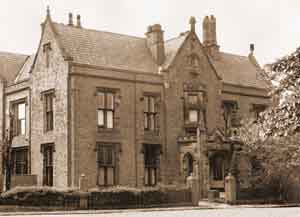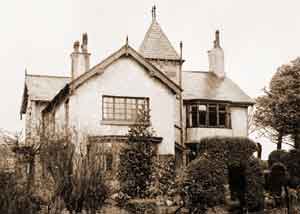

Red Hall
This hall was located in Audenshaw Village on the west side of Taylor Ln. The estate was given to Captain Ralph Stopford by Protector Oliver Cromwell and it was built in 1672. It was demolished in 1876 to facilitate the construction of Audenshaw Reservoirs because it was on the site for Reservoir No. 1.
A prominent resident of the hall between 1846 and 1850 was Evan Leigh (3 Feb 1811-2 Feb 1876), a machinery manufacturer and inventor of improved cotton spinning machinery. He was resident with his wife, Ann Allen, and family. The last known resident was the widower, Isaac Shimwell (1805-9 Aug 1875), a smallware manufacturer, who was resident between 1863 and 1871.

The original Red Hall Methodist Chapel
This chapel was located in Audenshaw Village on the east side of Taylor Ln. It opened in 1782 and was demolished in 1876 to facilitate the construction of Audenshaw Reservoirs. It was on the site for Reservoir No. 3.
A replacement chapel was built on the north side of Audenshaw Rd close to the site of the earliest chapel.

The replacement Red Hall Methodist Chapel
This chapel opened in 1876 and was demolished in 2007 to be superseded by a third chapel built on the same site.

Cemetery Chapel, c.1950
The architects for this chapel were T George & Son of Stamford St, Ashton-under-Lyne, the partners being Thomas and William Henry George. The cemetery opened in 1905.

Shepley Hall & Shepley Hall Farm
Both buildings were on the north side of Shepley Rd, Hooley Hill. In this view the hall is on the right and the later Shepley Hall Farm is on the left. Originally, the hall was the home of the Shepley family followed by the Assheton family. In the early 20th century Henry Williams was resident at the hall and John Massey was resident at the farm. In 1939 the farmer was Benjamin Alderson Phillips. The Shepley Industrial Estate now stands on the site of these buildings.

Methodist New Connexion Chapel
The chapel was on the south side of Shepley Rd, Hooley Hill, and this view is from the corner of Cartwright St. The chapel is on the right and the Sunday school is on the left. It was founded in 1858 and the architect for the build was Joseph Lindley of Ashton-under-Lyne. In 1907 the Methodist New Connexion merged with the Bible Christian Church and the United Free Church to form the United Methodist Church. The chapel closed in 1962.

Audenshaw Hall
This hall stood on the south side of Audenshaw Rd at its junction with Manchester Rd. The hall was built in c.1877 and it was demolished in the 1960s. By 1901 it was the residence of Rupert Mason JP who was the son of Hugh Mason, a cotton mill owner and social reformer of Ashton-under-Lyne.

Fairfield House
This house stood on the south side of Manchester Rd next to Audenshaw Hall and opposite the entrance to Ashton Hill Ln. By 1939 Frederick Carrington Wilcock, a leather belting manufacturer, was the resident. The Fairfield Arms now stands on the site.

Booth House
This house stood on the south side of Manchester Rd between Fairfield House and Stanley House. By 1901 Joseph Hadwen JP was the resident but he died in the same year and the house was put up for sale. This view shows the Droylsden Prize Reed Band in front of the house.

Mawson Hall
This hall stood on the north side of Corn Hill Ln almost opposite Debdale Farm. By 1939 it was the residence of Alfred Wilson and his wife, Clara née Jones. Alfred was a director of Joseph Wilson & Sons Ltd, hat manufacturers of Denton.

Church Inn
This inn stood on the north side of Audenshaw Rd near Hanover St.
In 1901 the widowed Eliza Stopford (45) was the publican resident with her five children and servant.

Claytons Farm, early 20th century
This farm stood on the west side of Denton Ln near its junction with Stamford Rd and Guide Ln, Hooley Hill.

Red Lion Hotel
This public house stood on Guide Ln, Hooley Hill, next door to the Old Pack Horse.
In 1901 Thomas Rose was the publican and he was resident with his wife, Mary Ann, and two daughters.

Junction Inn
This inn stood off Guide Ln, Hooley Hill, on the approach to Guide Bridge Station.
In 1901 William Pollitt (61) was the publican.

Guide Bridge Station, late 1970s
On Guide Ln, Hooley Hill. View looking west showing the southern platforms and office building. Platform 3 is on the right and Platform 4 is on the left.

Guide Bridge Station, 1980
Office building viewed from the south.

Railway Goods Warehouse, late 1970s
This warehouse stood in Cock Lane* Sidings on the west side of Guide Ln, opposite Guide Bridge Station.
The writing on the gable is, ‘LONDON & NORTH WESTERN RLY’ overwritten with ‘LONDON & SCOTTISH RLY’ and ‘GOODS WAREHOUSE’.
*Cock Ln is now Stamford Rd.

Ivy Cottage, c.1910
This cottage stood on the east side of Stamford Rd (formerly Cock Ln) near Coronation Square.

Jessamine Cottage, c.1900
This cottage, on the right, stood on Audenshaw Rd and this view is from the embankment of Audenshaw Reservoir No. 3.
Trafalgar House is to its left and this building is still extant.
The cottage name is a variant of ‘Jasmine’ which refers to shrubs renowned for their fragrance.